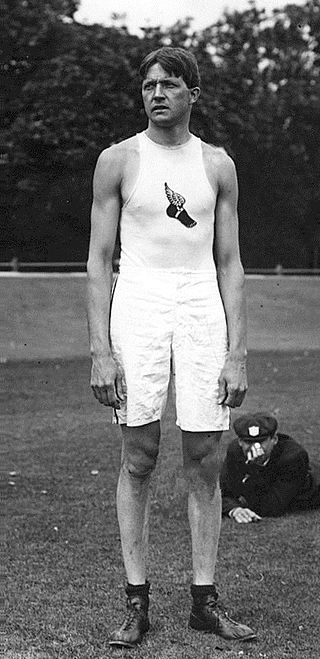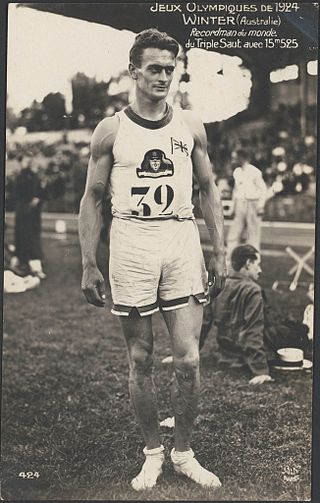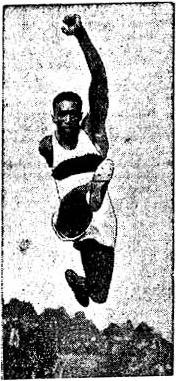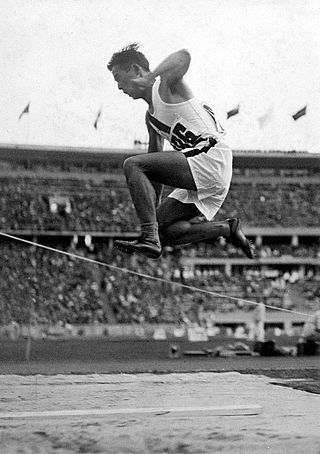Olympic medalists
| Games | Gold | Silver | Bronze |
|---|---|---|---|
| 1900 Paris | |||
| 1904 St. Louis |
Standing triple jump is an athletics event based on the conventional triple jump with three jumping phases, but without an approach run-up. It is one of three standing variants of track and field jumping events, along with the standing high jump and standing long jump.
While it is no longer an official competitive event, it is still used as a training exercise. [1]
The first phase is a hop from a stand still, which requires the athlete to take-off from a two-footed stand, split in mid air, and land on the preferred foot. The next phase is a long stretched step, landing on the opposite foot. The last phase is the jump, where the athlete lands on both feet. The winner is the competitor who achieves the longest distance on one of the 3 or 6 attempts.
Competitions in standing triple jump are not very common today, but the event was included in the 1900 [2] and 1904 Summer Olympics. [3]
| Games | Gold | Silver | Bronze |
|---|---|---|---|
| 1900 Paris | |||
| 1904 St. Louis |

The long jump is a track and field event in which athletes combine speed, strength and agility in an attempt to leap as far as possible from a takeoff point. Along with the triple jump, the two events that measure jumping for distance as a group are referred to as the "horizontal jumps". This event has a history in the ancient Olympic Games and has been a modern Olympic event for men since the first Olympics in 1896 and for women since 1948.

The triple jump, sometimes referred to as the hop, step and jump or the hop, skip and jump, is a track and field event, similar to long jump. As a group, the two events are referred to as the "horizontal jumps". The competitor runs down the track and performs a hop, a bound and then a jump into the sand pit. The triple jump was inspired by accounts of lengthy jumps at the ancient Olympic Games and has been a modern Olympics event since the Games' inception in 1896.

Raymond Clarence Ewry was an American track and field athlete who won eight gold medals at the Olympic Games and two gold medals at the Intercalated Games. This puts him among the most successful Olympians of all time.

The standing long jump, also known as the standing broad jump, is an athletics event. It was an Olympic event until 1912. It is one of three standing variants of track and field jumping events, which also include the standing high jump and standing triple jump.
The standing high jump is an athletics event that was featured in the Olympics from 1900 to 1912. It is performed in the same way as high jump, with the difference being that the athlete has no run-up and must stand still and jump with both feet together.

Athletics has been contested at every Summer Olympics since the birth of the modern Olympic movement at the 1896 Summer Olympics. The athletics program traces its earliest roots to events used in the ancient Greek Olympics. The modern program includes track and field events, road running events, and race walking events. Cross country running was also on the program in earlier editions but it was dropped after the 1924 Summer Olympics.

The men's triple jump was one of six jumping events on the Athletics at the 1908 Summer Olympics programme in London. The competition was held on 25 July 1908. Twenty athletes from eight nations competed. NOCs could enter up to 12 athletes. The event was won by Tim Ahearne of Great Britain, breaking a streak of three American victories in the triple jump. All three medal-winning nations were on the podium for the first time.

The men's triple jump, also known as the hop, step, and jump, was a track and field athletics event held as part of the Athletics at the 1912 Summer Olympics programme. The competition was held on Monday, July 15, 1912. Twenty athletes from eight nations competed. NOCs could enter up to 12 athletes. The event was won by Gustaf Lindblom of Sweden, the nation's first medal in the men's triple jump. Georg Åberg and Erik Almlöf also medaled for Sweden, completing a sweep—previously accomplished twice by the United States in 1900 and 1904.

The men's triple jump event was part of the track and field athletics programme at the 1920 Summer Olympics. The competition was held from Thursday, August 19, 1920, to Saturday, August 21, 1920. Twenty-one triple jumpers from eight nations competed. No nation had more than four jumpers, suggesting the limit had been reduced from the 12 maximum in force in 1908 and 1912. The event was won by Vilho Tuulos of Finland, the nation's first medal in the triple jump. Sweden, which had swept the medals in 1912, took the next three places. Erik Almlöf became the third man to win two medals in the event, repeating his bronze performance from 1912.
The men's triple jump event at the 1980 Summer Olympics in Moscow, Soviet Union had an entry list of 23 competitors, with two qualifying groups before the final (12) took place on Friday, July 25, 1980. The maximum number of athletes per nation had been set at 3 since the 1930 Olympic Congress. The top twelve and ties, and all those reaching 16.55 metres advanced to the final. The qualification round was held on Thursday, July 24, 1980.

The men's triple jump event was part of the track and field athletics programme at the 1924 Summer Olympics. The competition was held on Saturday, July 12, 1924. Twenty triple jumpers from twelve nations competed. The maximum number of athletes per nation was 4. The event was won by Nick Winter of Australia, the nation winning gold in its debut in the event. Argentina also medaled in its first triple jump appearance, with Luis Brunetto taking silver. Defending champion Vilho Tuulos of Finland took bronze, the fourth man to win a second medal in the event.
The men's triple jump event at the 2000 Summer Olympics as part of the athletics program was held at the Olympic Stadium. Forty athletes from 27 nations competed. The maximum number of athletes per nation had been set at 3 since the 1930 Olympic Congress. The triple jump has been ever present since the beginning of the modern Olympic Games in 1896. The event was won by Jonathan Edwards of Great Britain, the nation's first victory in the men's triple jump since 1908. Edwards became the 12th man to win two medals in the event, adding gold to his 1996 silver. Yoel García's silver put Cuba on the podium for the second Games in a row.

Adhemar Ferreira da Silva was a Brazilian triple jumper. He won two Olympic gold medals and set four world records, the last being 16.56 metres in 1955 Pan American Games. In his early career he also competed in the long jump, placing fourth at the 1951 Pan American Games. He broke world records in triple jump on five occasions during his illustrious career. To date, he remains the only track and field athlete from South America to have won two Olympic gold medals.

The men's triple jump event at the 1928 Olympic Games took place on August 2. Twenty-four athletes from 13 nations competed. The maximum number of athletes per nation was 4. The event was won by Mikio Oda of Japan, the nation's first medal in the men's triple jump. Levi Casey put the United States on the podium for the first time since 1924, with his silver. Vilho Tuulos of Finland took bronze, the first man to win a third medal in the event.

The men's triple jump event at the 1932 Olympic Games took place August 4. Sixteen athletes from 12 nations competed. The 1930 Olympic Congress in Berlin had reduced the limit from 4 athletes per NOC to 3 athletes. Chūhei Nambu of Japan won gold with a world record breaking jump. It was Japan's second consecutive gold medal in the men's triple jump; Japan also became the third nation to have two medalists in the event in the same Games as Kenkichi Oshima took bronze. Sweden took its first medal in the event since 1920 with Erik Svensson's silver.

The men's triple jump event was part of the track and field athletics programme at the 1936 Summer Olympics. The competition was held on August 6, 1936. Thirty-one athletes from 19 nations competed. The maximum number of athletes per nation had been set at 3 since the 1930 Olympic Congress. The final was won by Naoto Tajima of Japan with a world-record jump. It was Japan's third consecutive gold medal in the men's triple jump; as of the 2016 Games, it is the last gold medal Japan has won in the event. Masao Harada's silver medal made it the second Games in which Japan put two men on the podium in the event. Jack Metcalfe of Australia earned bronze, Australia's first medal in the event since 1924.

The high jump at the Summer Olympics is grouped among the four track and field jumping events held at the multi-sport event. The men's high jump has been present on the Olympic athletics programme since the first Summer Olympics in 1896. The women's high jump was one of five events to feature on the first women's athletics programme in 1928, and it was the only jumping event available to women until 1948, when the long jump was permitted.

The long jump at the Summer Olympics, is grouped among the four track and field jumping events held at the multi-sport event. The men's long jump has been present on the Olympic athletics programme since the first Summer Olympics in 1896. The women's long jump was introduced over fifty years later in 1948, and was the second Olympic jumping event for women after the high jump, which was added in 1928.

The triple jump at the Summer Olympics is grouped among the four track and field jumping events held at the multi-sport event. The men's triple jump has been present on the Olympic athletics programme since the first Summer Olympics in 1896. The women's triple jump is one of the more recent additions to the programme, having been first contested in 1996. It became the third Olympic jumping event for women after the high jump and long jump.
Athletics was one of the sports at the biennial Far Eastern Championship Games. Athletics competitions were held at every one of the ten editions of the games, which existed between 1913 and 1934. This represented the first time that a regular major international athletics competition occurred between Asian nations. It was later succeeded by athletics at the Asian Games, which began in 1951.